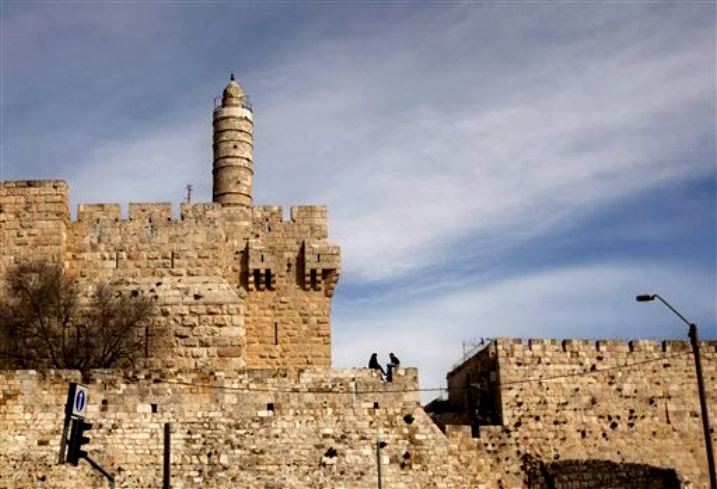
After a series of five moderate earthquakes shook the country in October, experts installed a seismic monitoring system at the Tower of David, one of Jerusalem's most important—and most visible—historical sites.
The project is Israel's first attempt to use such technology to determine structural weaknesses in the countless ancient edifices that dot the Holy Land. The efforts, however, have been slowed by authorities' reticence to publically declare sites as vulnerable, as well as the explosive geopolitics surrounding ancient Jewish, Christian and Muslim sites at the heart of the Mideast conflict.
"We have to remember that this is the Holy Land," said Avi Shapira, head of a national steering committee for earthquake preparedness. "We have some responsibility not only to preserve the historical monuments of our personal heritage ... but also for the rest of the world."
Most of Israel's historical sites "have not been checked," said Shapira. "We have them on the map, but an engineer still hasn't visited them."
Israel sits along the friction point of the African and Arabian tectonic plates, and is prone to small tremors. The earthquakes in October caused no major damage, but made Israelis jittery. About once a century throughout history, a large earthquake has rattled the region, often damaging key historical sites. The last major quake occurred in 1927.
The Al-Aqsa Mosque, Islam's third holiest site, was destroyed in an earthquake shortly after it was built in the 8th century and was damaged and repaired multiple times since due to quakes. The 1927 quake, which was over 6 in magnitude, caused hundreds of deaths and damaged Al-Aqsa and the Church of the Holy Sepulcher, built on the site where Jesus is believed to have been crucified and buried.
Israel has been bracing for another major earthquake for years. But those efforts have focused on retrofitting existing schools and hospitals and apartment buildings, and improving standards in new construction.
The country is just getting around to surveying its historical sites, and the assessment process has turned out to be sensitive.
Government experts have not published any findings on historical sites at risk, and it is unclear which government authority would be compelled to take responsibility for sites should they face earthquake damage.
Political sensitivities have prevented Israeli officials from conducting earthquake-impact assessments on the region's most revered, most ancient, and likely most vulnerable sites, including the gold-capped Dome of the Rock, said an official on Israel's earthquake preparedness steering committee. The official spoke on condition of anonymity because he was not authorized to brief the media.
In the past, Israeli involvement in the Old City's ancient buildings has sparked protest from Palestinians who seek sovereignty there in their quest for an independent state.
After a centuries-old access ramp to a key holy site was damaged by stormy weather in 2004, Arab and Muslim leaders worldwide protested Israeli excavation work in preparation for the construction of a new ramp, accusing Israel of impinging on the site with conflicting ownership claims.
The site, known to Jews as the Temple Mount and to Muslims as the Noble Sanctuary, has ignited violence when Muslims have perceived Israel to encroach upon the compound.
Israel's Antiquities Authority, in charge of conserving the country's ancient sites, declined comment on the earthquake assessment efforts.
The only site in the Old City that Israeli officials say is being checked for a possible earthquake risk is the Tower of David, one of Jerusalem's most ubiquitous symbols. The minaret-topped stone tower stands in the corner of an ancient citadel fortress, and six major cracks in the tower have the staff worried if it can withstand an earthquake.
"This is the symbol of the city, the symbol of Jerusalem, for more than 2000 years. So that's why this is a real nightmare for us," said Eilat Lieber, director of the Tower of David museum.
Researchers from the University of Padua in Italy installed sensors throughout the tower to determine what kind of earthquake-proofing it might need.
Accelerometers along the tower measure small movements caused by wind and traffic, in order to predict how an earthquake would impact the structure. At the very top of the minaret, thin bars affixed to the stones slide like bicycle tire pumps to measure the movement of cracks. Data collected by the equipment will be analyzed to determine any structural flaws in the tower and if needed, to suggest engineering solutions to stabilize the site.
The Tower of David is the first historical site in Jerusalem to be outfitted with the seismic sensors. Israeli experts are considering using the technology at other Israeli historical sites.
Experts said the monitoring technology is already in place in the famous Qutab Minar monument in New Delhi, minarets in Bosnia-Herzegovina, and various sites in Italy, including bell towers in Venice, the ancient Verona Arena in Verona, and locations in L'Aquila, following a devastating 2009 earthquake that wreaked havoc on cultural heritage buildings.
Initial assessments for the Tower of David are good. Claudio Modena, a University of Padova engineer, said the tower seems to be capable of withstanding an earthquake because its ancient foundations sit on bedrock. Three steel rings that hug the cracked minaret, installed during earlier British rule in the city, have helped save it from collapse, he said.
Orna Cohen, chief conservator of the Tower of David, said that in the event of an earthquake, Jerusalem's most ancient structures of massive stones might actually be the city's most dependable.
"If they still stand after so many earthquakes during the last 2000 years, they must be good structures," Cohen said.
Author: Daniel Estrin | Source: Associated Press [January 21, 2014]